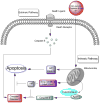Apoptosis in acquired and genetic hearing impairment: the programmed death of the hair cell
- PMID: 21782914
- PMCID: PMC3341727
- DOI: 10.1016/j.heares.2011.07.002
Apoptosis in acquired and genetic hearing impairment: the programmed death of the hair cell
Abstract
Apoptosis is an important physiological process. Normally, a healthy cell maintains a delicate balance between pro- and anti-apoptotic factors, allowing it to live and proliferate. It is thus not surprising that disturbance of this delicate balance may result in disease. It is a well known fact that apoptosis also contributes to several acquired forms of hearing impairment. Noise-induced hearing loss is the result of prolonged exposure to excessive noise, triggering apoptosis in terminally differentiated sensory hair cells. Moreover, hearing loss caused by the use of therapeutic drugs such as aminoglycoside antibiotics and cisplatin potentially may result in the activation of apoptosis in sensory hair cells leading to hearing loss due to the "ototoxicity" of the drugs. Finally, apoptosis is a key contributor to the development of presbycusis, age-related hearing loss. Recently, several mutations in apoptosis genes were identified as the cause of monogenic hearing impairment. These genes are TJP2, DFNA5 and MSRB3. This implies that apoptosis not only contributes to the pathology of acquired forms of hearing impairment, but also to genetic hearing impairment as well. We believe that these genes constitute a new functional class within the hearing loss field. Here, the contribution of apoptosis in the pathology of both acquired and genetic hearing impairment is reviewed.
Copyright © 2011 Elsevier B.V. All rights reserved.
Conflict of interest statement
The authors declare no conflict of interest.
Figures



References
-
- Ahmed ZM, Yousaf R, Lee BC, Khan SN, Lee S, Lee K, Husnain T, Rehman AU, Bonneux S, Ansar M, Ahmad W, Leal SM, Gladyshev VN, Belyantseva IA, Van Camp G, Riazuddin S, Friedman TB, Riazuddin S. Functional null mutations of MSRB3 encoding methionine sulfoxide reductase are associated with human deafness DFNB74. Am J Hum Genet. 2011;88:19–29. - PMC - PubMed
-
- Ahn JH, Kang HH, Kim YJ, Chung JW. Anti-apoptotic role of retinoic acid in the inner ear of noise-exposed mice. Biochem Biophys Res Commun. 2005;335:485–90. - PubMed
-
- Alam SA, Ikeda K, Oshima T, Suzuki M, Kawase T, Kikuchi T, Takasaka T. Cisplatin-induced apoptotic cell death in Mongolian gerbil cochlea. Hear Res. 2000;141:28–38. - PubMed
-
- Arslan E, Orzan E, Santarelli R. Global problem of drug-induced hearing loss. Ann N Y Acad Sci. 1999;884:1–14. - PubMed
Publication types
MeSH terms
Substances
Grants and funding
LinkOut - more resources
Full Text Sources
Other Literature Sources

